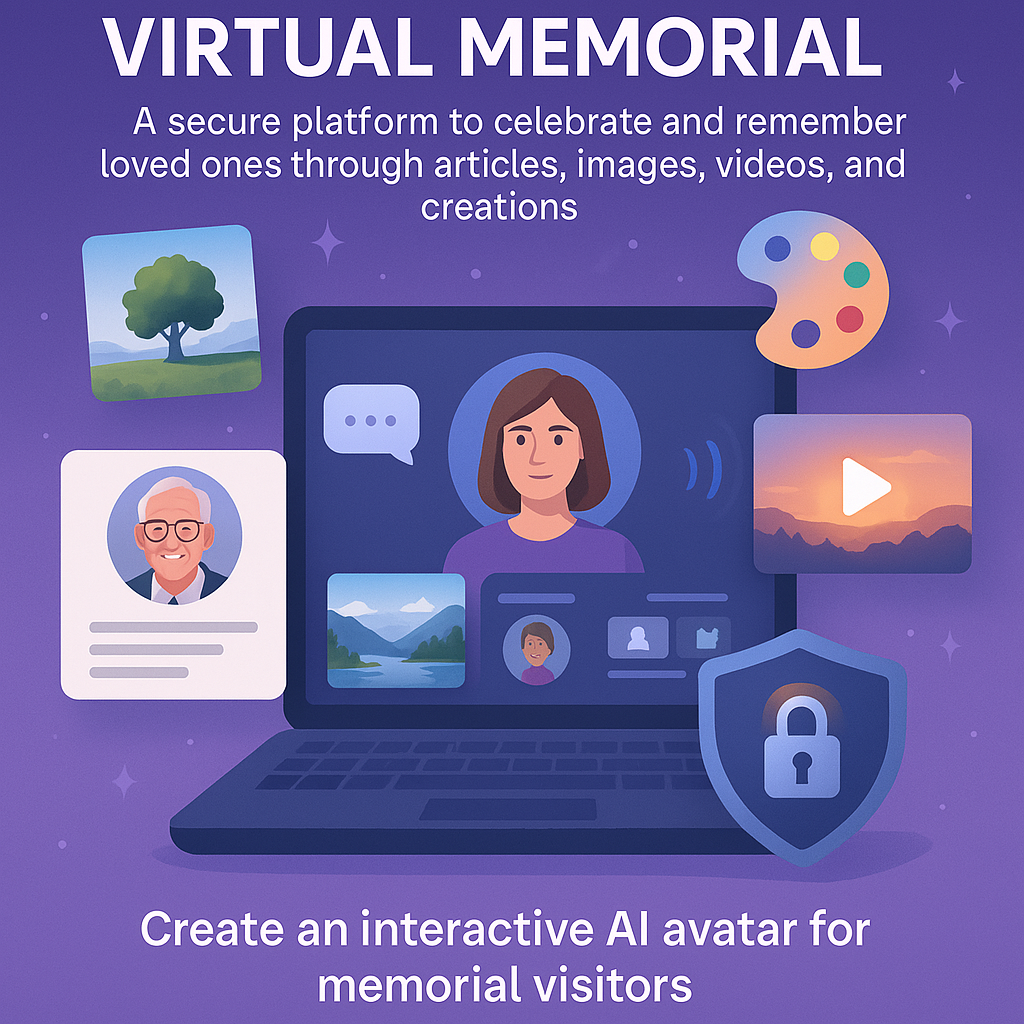EverPresence: A Secure, AI-Integrated Platform for Persistent Digital Memorialization
Abstract
EverPresence is a novel software platform designed to provide a persistent, multimedia-enabled memorial space for deceased individuals, with a focus on data integrity, privacy, and AI-driven legacy preservation. This article outlines the architectural underpinnings of the platform, its security infrastructure, data model, and the integration of AI technologies for posthumous interaction via user-trained avatars.
1. Introduction
The concept of digital memorialization has evolved significantly in recent years, particularly as cloud infrastructure and AI models have matured. EverPresence aims to address two key challenges in this space: (1) how to provide a scalable, secure, and expressive memorial space, and (2) how to ethically implement AI avatars trained on a living user’s interactions for posthumous engagement.
2. System Architecture Overview
EverPresence is built as a modular, cloud-native platform, employing a microservices architecture to support scalable content management, user authentication, AI processing, and secure data storage. The frontend is built using a modern web stack (React, WebAssembly modules for media rendering), with responsive design principles for accessibility across devices. The backend services leverage containerized environments (Docker, Kubernetes) for portability and dynamic scaling.
Key subsystems include:
-
Content Management Engine: Supports structured and unstructured uploads including text, audio, video, image, and document formats. Metadata is extracted and indexed for semantic search and timeline generation.
-
Interactive Memorial Framework: Enables user-generated memory walls, life timelines, and collaborative storytelling. Real-time features are enabled via WebSocket layers for live memorial events.
-
Legacy Avatar System: (Described in Section 5)
3. Data Security and Privacy Infrastructure
All memorial data is considered highly sensitive. To protect user content and ensure long-term integrity, EverPresence employs a multilayered security model:
-
End-to-End Encryption: All data in transit is protected via TLS 1.3, and at-rest data is encrypted using AES-256.
-
Zero-Knowledge Architecture (Optional): For memorials requiring maximal privacy, data can be encrypted client-side with user-controlled keys.
-
Granular Access Controls: Role-based permissions allow creators to designate who can view, contribute, or manage each memorial.
-
Immutable Audit Trails: Write-once logging infrastructure ensures transparency and traceability without compromising privacy.
Redundancy is maintained through distributed backups and IPFS-based archival storage, ensuring long-term persistence even in the event of centralized service disruption.
4. Multimedia and Narrative Design
Each memorial supports multimodal contributions to create a rich biographical archive. This includes:
-
Natural Language Storytelling: Markdown-enabled text entries with support for embedded media
-
Audio/Visual Memory Capsules: Users can attach time-stamped recordings and videos that play within a temporal context (e.g., “last birthday message”)
-
Interactive Life Maps: A geospatial feature that plots key life events on an interactive globe, constructed via NLP-based extraction of location data
The memorial space is designed to remain expandable, supporting versioned contributions over time by multiple authorized users.
5. AI-Powered Legacy Avatars
A distinguishing feature of EverPresence is the Legacy Avatar — a conversational AI agent designed to emulate a deceased individual based on their prior interactions with the platform.
5.1 Training Process
Users can opt-in to train an avatar during their lifetime by interacting with a conversational agent embedded within the platform. The training data includes:
-
Chat interactions
-
Journal entries
-
Uploaded voice samples (for optional voice synthesis)
-
Multimedia captions and tagged metadata
These inputs are used to fine-tune a local LLM instance, coupled with embeddings stored in a vector database (e.g., Faiss or Milvus). For voice cloning, voiceprints are generated using a consent-based, fine-grained voice model (such as a Tacotron/HiFi-GAN pipeline or equivalent).
5.2 Posthumous Interaction
Upon activation (post-mortem, with executor approval), the avatar becomes available on the memorial page. It supports natural language Q&A, memory retrieval, and sentiment-based storytelling. Contextual grounding ensures the agent does not hallucinate beyond the known data corpus.
Ethical constraints and a memory scope limiter prevent the avatar from answering outside its trained knowledge — a safeguard to preserve authenticity and prevent misinformation.
6. Ethical and Cultural Considerations
The deployment of AI avatars in memorial contexts raises important ethical questions. EverPresence has implemented the following practices:
-
Informed Consent: Users must provide explicit, revocable consent to train an avatar.
-
Executor Controls: Memorial administrators can deactivate avatars or limit their availability.
-
Cultural Sensitivity: Localization tools allow memorials to reflect diverse mourning traditions and linguistic norms.
We are also engaging in ongoing review with digital ethics boards and cultural heritage advisors to shape responsible long-term policies.
7. Conclusion and Future Work
EverPresence represents a convergence of secure cloud infrastructure, AI personalization, and digital heritage preservation. As we iterate on this platform, future developments will include:
-
Federated learning for decentralized avatar training
-
Support for integration with genealogy platforms
-
Expansion into VR/AR memorial environments
By reimagining the way we remember and interact with the legacies of those we’ve lost, EverPresence opens new dimensions in how memory, identity, and technology converge.


